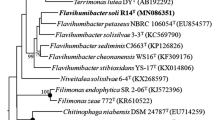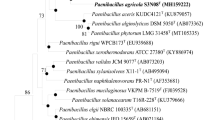Abstract
A Gram-stain negative, aerobic, motile and rod-shaped novel bacterial strain, designated MAH-3T, was isolated from soil sample of a rice field. The colonies were orange pigmented, smooth, circular and 0.4–0.9 mm in diameter when grown on R2A agar for 3 days. Strain MAH-3T was found to grow at 10–40 °C (optimum 30 °C), pH 6.0–8.0 (optimum 7.0) and in the presence of 0–1.0% NaCl (optimum 0%). Cell growth occurs on R2A agar and Luria–Bertani agar, but not on nutrient agar, tryptone soya agar and MacConkey agar. Cells were positive for catalase test but negative for oxidase test. Cells were able to hydrolyze casein, gelatin, DNA and Tween 80. 16S rRNA gene sequence analysis revealed that strain MAH-3T was most closely related to the genus Fluviicola and exhibited the highest sequence similarity to Fluviicola hefeinensis MYL-8T (97.4%), Fluviicola taffensis RW262T (96.2%) and Fluviicola kyonggii CA-1T (95.6%). Strain MAH-3T had a genome size of 4,271,694 bp and the genomic DNA G + C content was determined to be 41.7 mol%. The genome contained 19 contigs encoded by 3,664 protein-coding genes with 34 tRNA and 4 rRNA genes. The genomic ANI value between strain MAH-3T and one of the closely related type strains, F. taffensis DSM 16823T was 76.2%. The predominant isoprenoid quinone of isolated strain MAH-3T was menaquinone-6 (MK-6). The major fatty acids were identified as C15:0 iso, C15:0 2OH and C17:0 iso 3OH. On the basis of these phenotypic, genotypic and chemotaxonomic studies and DNA–DNA hybridization results, the isolated strain MAH-3T represents a novel species, for which the name Fluviicola chungangensis sp. nov. is proposed, with MAH-3T as the type strain (= KACC 19742T = CGMCC 1.13750T).

Similar content being viewed by others
References
Christensen WB (1946) Urea decomposition as a means of differentiating proteus and paracolon cultures from each other and from Salmonella and Shigella types. J Bacteriol 52:461–466
Collins MD (1985) Isoprenoid quinone analyses in bacterial classification and identification. In: Goodfellow M, Minnikin DE (eds) Chemical methods in bacterial systematics. Academic Press, London, pp 267–287
Collins MD, Jones D (1981) Distribution of isoprenoid quinone structural types in bacteria and their taxonomic implications. Microbiol Rev 45:316–354
Dahal RH, Kim J (2018) Fluviicola kyonggii sp. nov., a bacterium isolated from forest soil and emended description of the genus Fluviicola. Int J Syst Evol Microbiol 68:1885–1889
Ezaki T, Hashimoto Y, Yabuuchi E (1989) Fluorometric deoxyribonucleic acid-deoxyribonucleic acid hybridization in microdilution wells as an alternative to membrane filter hybridization in which radioisotopes are used to determine genetic relatedness among bacterial strains. Int J Syst Bacteriol 39:224–229
Fautz E, Reichenbach H (1980) A simple test for flexirubin-type pigments. FEMS Microbiol Lett 8:87–91
Felsenstein J (1985) Confidence limit on phylogenies: an approach using the bootstrap. Evol Int J Org Evol 39:783–791
Gillis M, De Ley J, De Cleene M (1970) The determination of molecular weight of bacterial genome DNA from renaturation rates. Eur J Biochem 12:143–153
Hall TA (1999) BioEdit: a user-friendly biological sequence alignment editor and analysis program for Windows 95/98/NT. Nucl Acids Symp Ser 41:95–98
Huq MA (2017) Chryseobacterium chungangensis sp. nov., a bacterium isolated from soil of sweet gourd garden. Arch Microbiol. https://doi.org/10.1007/s00203-017-1469-8
Kim OS, Cho YJ, Lee K, Yoon SH, Kim M, Na H, Park SC, Jeon YS, Lee JH, Yi H, Won S, Chun J (2012) Introducing EzTaxon-e: a prokaryotic 16S rRNA gene sequence database with phylotypes that represent uncultured species. Int J Syst Evol Microbiol 62:716–721
Kimura M (1983) The neutral theory of molecular evolution. Cambridge University Press, Cambridge
McConaughy BL, Laird CD, McCarthy BJ (1969) Nucleic acid reassociation in formamide. Biochemistry 8:3289–3295
Munoz R, Rosselló-Móra R, Amann R (2016) Revised phylogeny of Bacteroidetes and proposal of sixteen new taxa and two new combinations including Rhodothermaeota phyl. nov. Syst Appl Microbiol 39:281–296
Muramatsu Y, Takahashi M, Kamakura Y, Suzuki K, Nakagawa Y (2012) Salinirepens amamiensis gen. nov., sp. nov., a member of the family Cryomorphaceae isolated from seawater, and emended descriptions of the genera Fluviicola and Wandonia. Int J Syst Evol Microbiol 62:2235–2240
O’Sullivan LA, Rinna J, Humphreys G, Weightman AJ, Fry JC (2005) Fluviicola taffensis gen. nov., sp. nov., a novel freshwater bacterium of the family Cryomorphaceae in the phylum ’Bacteroidetes’. Int J Syst Evol Microbiol 55:2189–2194
Saitou N, Nei M (1987) The neighbor-joining method: a new method for reconstructing phylogenetic trees. Mol Bio Evol 4:406–425
Sasser M (1990) Identification of bacteria through fatty acid analysis. In: Klement Z, Rudolph K, Sands DC (eds) Methods in Phytobacteriol. Akademiai Kaido, Budapest, pp 199–204
Skerman VBD (1967) A guide to the identification of the genera of bacteria, 2nd edn. Williams and Wilkins, Baltimore
Stabili L, Gravili C, Tredici SM, Piraino S, Talà A, Boero F, Alifano P (2008) Epibiotic Vibrio luminous bacteria isolated from some hydrozoa and bryozoa species. Microb Ecol 56:625–636
Stackebrandt E, Goebel BM (1994) Taxonomic note: a place for DNA-DNA reassociation and 16S rRNA sequence analysis in the present species definition in bacteriology. Int J Syst Bacteriol 44:846–849
Tamura K, Peterson D, Peterson N, Stecher G, Nei M, Kumar S (2011) MEGA5: molecular evolutionary genetics analysis using maximum likelihood, evolutionary distance, and maximum parsimony methods. Mol Biol Evol 28:2731–2739
Thompson JD, Gibson TJ, Plewniak F, Jeanmougin F, Higgins DG (1997) The CLUSTAL_X windows interface: flexible strategies for multiple sequence alignment aided by quality analysis tools. Nucleic Acids Res 25:4876–4882
Wayne LG, Brenner DJ, Colwell RR, Grimont PAD, Kandler O, Krichevsky MI, Moore LH, Moore WEC, Murray RGE (1987) International committee on systematic bacteriology. Report of the ad hoc committee on reconciliation of approaches to bacterial systematics. Int J Syst Bacteriol 37:463–464
Weisburg WG, Barns SM, Pelletier DA, Lane DJ (1991) 16S ribosomal DNA amplification for phylogenetic study. J Bacteriol 173:697–7032
Woyke T, Chertkov O, Lapidus A, Nolan M, Lucas S, Del Rio TG, Tice H (2011) Complete genome sequence of the gliding freshwater bacterium Fluviicola taffensis type strain (RW262). Stand Genomic Sci 5:21–29
Yang HX, Wang X, Liu XW, Zhang J, Yang GQ, Lau KW, Li SP, Jiang JD (2014) Fluviicola hefeinensis sp. nov., isolated from the wastewater of a chemical factory. Int J Syst Evol Microbiol 64:700–704
Yoon SH, Ha SM, Lim JM, Kwon SJ, Chun J (2017) A large-scale evaluation of algorithms to calculate average nucleotide identity. Antonie Van Leeuwenhoek 110:1281–1286
Acknowledgements
This study was performed with the support of the National Research Foundation (NRF) of Korea grant (Project no. NRF-2018R1C1B5041386, Recipient: Md. Amdadul Huq) funded by Korean government, Republic of Korea.
Author information
Authors and Affiliations
Corresponding author
Additional information
Communicated by Erko Stackebrandt.
Publisher's Note
Springer Nature remains neutral with regard to jurisdictional claims in published maps and institutional affiliations.
The NCBI GenBank accession numbers for the 16S rRNA gene and draft-genome sequence of strain MAH-3T are MH368763 and VLPL00000000, respectively.
Electronic supplementary material
Below is the link to the electronic supplementary material.
Rights and permissions
About this article
Cite this article
Akter, S., Huq, M.A. Fluviicola chungangensis sp. nov., a bacterium isolated from rice field. Arch Microbiol 202, 293–298 (2020). https://doi.org/10.1007/s00203-019-01746-5
Received:
Revised:
Accepted:
Published:
Issue Date:
DOI: https://doi.org/10.1007/s00203-019-01746-5




